If you head to the aquarium and look for those adorable little seahorses, you’ll see some vividly colored creatures of the deep. But what if the next time you visit, the same species are different colors? Why is that? Do seahorse colors change over time? Do the same seahorse species come in different colors?
Let’s take a look at these fascinating animals of the ocean: the what, why, and how of their colors and whether or not their colors change.
Basic Description of Seahorses
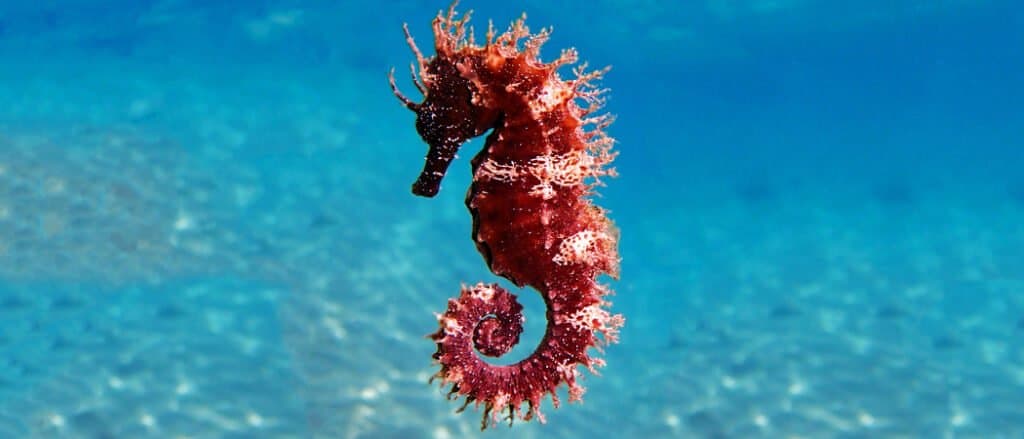
Not all seahorses look the same. They come in many shades and sizes, some with spines, and some without. Each species seems to have distinct markings that help to distinguish them from another.
©Vojce/Shutterstock.com
The “horses of the sea” offer beautiful, vibrant colors and unique looks wherever they go. Seahorses are generally docile, friendly, and social bony fish. They don’t have scales, but rather skin that stretches over their series of bony plates arranged in rings throughout their bodies. Each species of seahorse has a distinct number of rings that make up the body armor they bear, which protects them from predators. Interestingly enough, their coloration also plays into protection, but we’ll look at that later.
These tiny fish may be as small as 0.6 inches to 13.8 inches “tall” and earned their name for their rather equine-like appearance. The bent necks, distinctive trunks and tails, and long-snouted heads all suggest “horse.” They swim upright, propelling themselves along using their dorsal fins. The only other known fish to swim like this is the razorfish.
Seahorses have pectoral fins on either side of their heads, behind their eyes, and use them for steering. They don’t have caudal fins (on their backs) and their prehensile tails are made up of square rings that may unlock in extreme conditions.
Because of their body makeup, these little fish tend to be poor swimmers. They flutter their dorsal fins rapidly and use the pectoral fins to steer, but they’re one of the slowest moving fish species in the world. The dwarf seahorse (Hippocampus zosterae) is actually believed to be the absolute slowest-swimming fish on the planet, with a top speed of only 5 feet per hour.
Because of their lack of aquatic sports skills, these fish hang out most of their lives in pretty chill locations where they can safely survive as nearly stationary objects. This is another reason their coloration is so important.
Let’s take a look.
Seahorse Colors
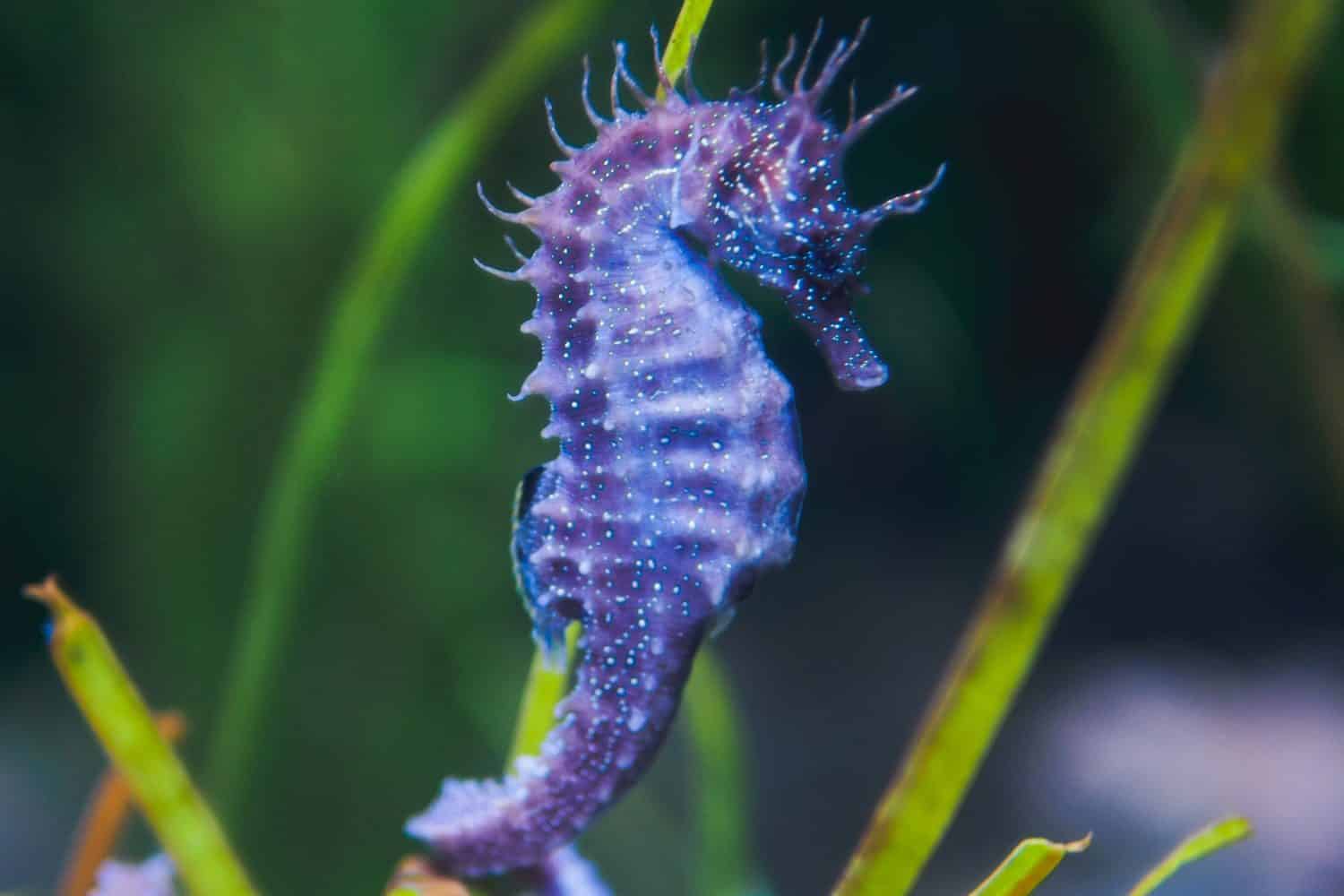
The rarest seahorse shade is purple.
©paulzhuk/Shutterstock.com
Seahorses have many shades and patterns. Many have multiple colors, depending on their environment, mood, or diet. The rarest shades are purple, gray, and white. The most commonly seen hues are brown, green, and yellow.
The intriguing part about seahorse colors, though, is that the creatures actually change their colors and live like chameleons in their habitats. They match their surroundings quickly when they feel threatened, blending into the background when predators are near. They also change colors as a part of their mating rituals.
Typically, seahorses that live in coral reefs have brighter colors, while those in darker waters tend to be darker in shade. Interestingly, happy seahorses also tend to be brighter in color.
In short, seahorse colors are (from rarest):
- Purple
- Gray
- White
- Blue
- Orange
- Pink
- Red
- Yellow
- Green
- Brown
Seahorse Markings
Seahorses often have markings on their bodies that add another layer of coloring to their unique little selves. They may have saddling, stars, lines, squiggles, or other markings. These often come in complementary or contradictory shades to their main body color.
Why Do Seahorses Have Such Bright Coloration?
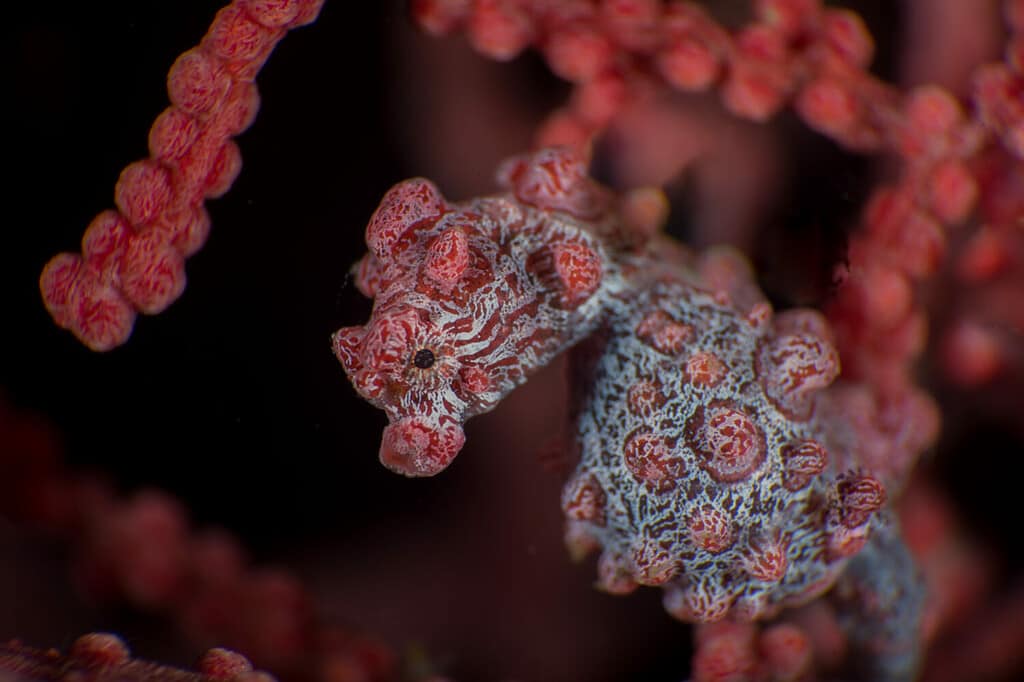
The tiny pygmy seahorse not only comes in many bright colors, but it has unique markings. Many seahorses have unique looks that help them blend in with their environments easily for protection against predators.
©Albert Saiz Tezanos/Shutterstock.com
The vibrant colors in seahorses, as mentioned, are largely due to their environment. Theories land mostly around the colors helping them to naturally blend into their environment for safety reasons. This is especially thought to be true for males building their nests among corals and plants.
Other theories suggest that the bright colors help the seahorses communicate with one another. Their coloration signals mood, and since these beautiful animals are highly social, this would likely help other seahorses know how to respond to each other. The coloring and markings are also thought to help identify one seahorse from another, which may also help them communicate.
Can Seahorses Change Colors?
As noted, seahorses do, indeed, have the ability to change colors. Three known reasons create the color change:
- Blending into surrounding areas for safety (hiding from predators in plain sight)
- Indicating mood to each other
- Showing interest (or lack thereof) in one another (mating rituals involve color changes)
How Do Seahorses Change Color?
Seahorses have special cells in their skin called chromatophores. These cells contain pigments and may expand or shrink, as controlled by the seahorse’s nervous system. Chromatophores allow seahorses to change the color of their skin through this expansion or shrinkage quickly.
Common Types of Seahorses
There are six main types of seahorses that folks may recognize in pet stores or out in the wild.
Common Seahorse (Hippocampus kuda)

The common seahorse comes in many colors as their baseline coloration. Most commonly, you’ll see them in yellow to gray shades.
©ericscicluna/ via Getty Images
As you can guess from the name, the most well-known seahorse is the common seahorse. These have horse-like heads, bumpy bellies, and spiral tails. They are the most commonly found in the marine pet trade.
These fishes reach up to 12 inches long, with the males being larger than females. Males typically come in grayer shades with dark spots, while females tend toward more yellow shades. Both males and females may come in any number of colors. This is especially true since they tend to change their colors frequently.
Common seahorses bear crowns on their heads, each as unique as a human fingerprint. Their bodies tend to be smoother than other species, as well. Common seahorses are most likely to be found in coral reefs in the Indo-Pacific tropical waters.
Unfortunately, they have been hunted as pets and trophies to the point of being listed as vulnerable.
Pygmy Seahorse (Hippocampus bargibanti)

The pygmy seahorse is smallest known seahorse on the planet. This means it took a while for scientists to even find and identify this colorful species.
©Nichchima Anongjanya/ via Getty Images
Pygmy seahorses are some of the smallest in the world, coming in at only three-quarters inch maximum length. Commonly, pygmy seahorses come in pink, orange, yellow, or gray, blending in more easily with their natural colors this way. They have narrower snouts than other species, as well, making them easy to identify, even apart from their size.
These tiny seahorses live in large groups among soft corals and sea grasses, usually with at least 20 adults per group. They generally may be found in the western Pacific between southern Japan and northern Australia, near the Solomon Islands, and as far as New Caledonia.
Their tiny size helped keep this species hidden from humans for a long time, making them one of the most recent seahorse species discoveries. They were first discovered in New Caledonia by Georges Bargibant when he was discovering a Gorgonian fan. These fan corals are some of the main homes for these itsy-bitsy seahorses.
Leafy Seadragon (Phycodurus eques)
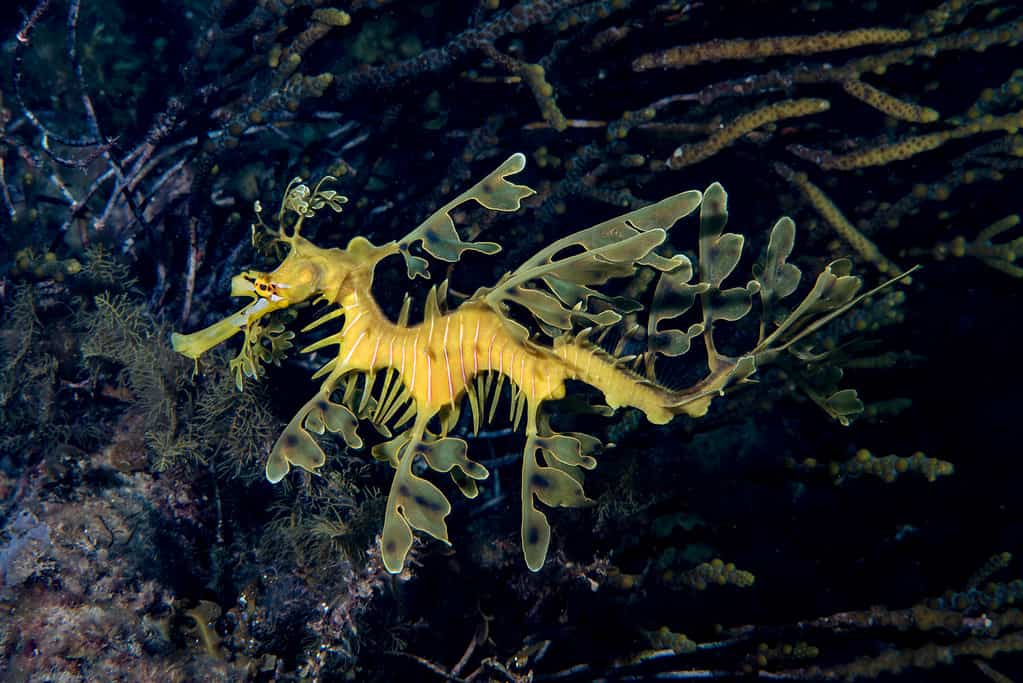
Leafy Seadragons look like they have leaves protruding from their bodies, earning them their unique common name. They come in many shades, though mostly more neutral colors like greens, yellows, and tans.
©Francesco_Ricciardi/Shutterstock.com
Bearing an equestrian scientific name, the leafy seadragon is a bit different than other seahorses. They do have seahorse-like qualities, but they also look a bit like slow-swimming plants. Their bodies have “leaves” attached to them, which they use for camouflage. If you’re not careful, you might swim right past one in the wild and think it is seaweed.
Leafy seadragons have pectoral and dorsal fins, with no prehensile tails, which also distinguishes them from other seahorse species. They are also on the larger side of the seahorse world, growing between 7.8 and 12 inches, normally.
These fish live in the ocean around southern Australia, only in Wilson’s Promontory in Victoria to Jurien Bay to the west, a bit north of Perth on Australia’s western coast.
Weedy Seadragon (Phyllopteryx taeniolatus)
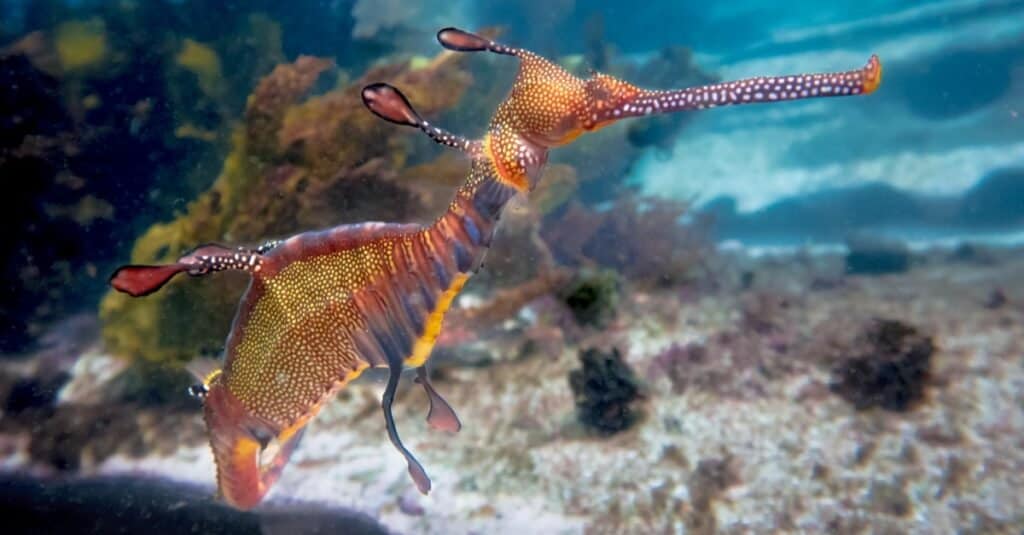
A beautiful, colorful Weedy Seadragon in Australia. Sea dragons are some of the most ornately camouflaged creatures on the planet.
©Ste Everington/Shutterstock.com
Similar to the leafy seadragon, weedy seadragons also have “leaves” on their bodies that help them blend into their environment. They grow between 12 and 15 inches in length, and hide in the wild waters of southern Australia and Tasmania. Weedy seadragons tend to be green or tan, with ridges, spots, and stripes. They also have no prehensile tails.
Big-belly Seahorse (Hippocampus abdominalis)
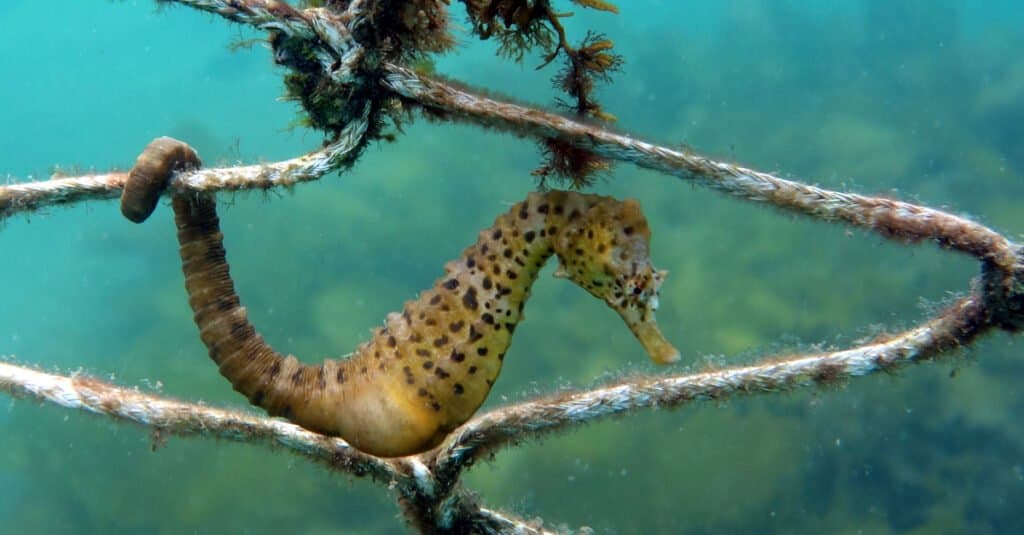
Big-belly or pot-belly seahorses are one of the largest known species of seahorses. They have large abdomens, which have earned them their name.
©Dirk van der Heide/Shutterstock.com
Sometimes called the pot-bellied seahorse, the big-belly seahorse may reach up to 14 inches in length. They have snouts that tip forward more than other species’ snouts, and a coiled, prehensile tail. Their wide stomachs earn them their name, with females having smaller abdomens than males. Males also have longer tails and wider snouts, but females have a keel down their middle.
These seahorses live in the waters near Australia and New Zealand where waters stay warm, between 70 and 80 degrees F or warmer.
Pacific Seahorse (Hippocampus ingens)
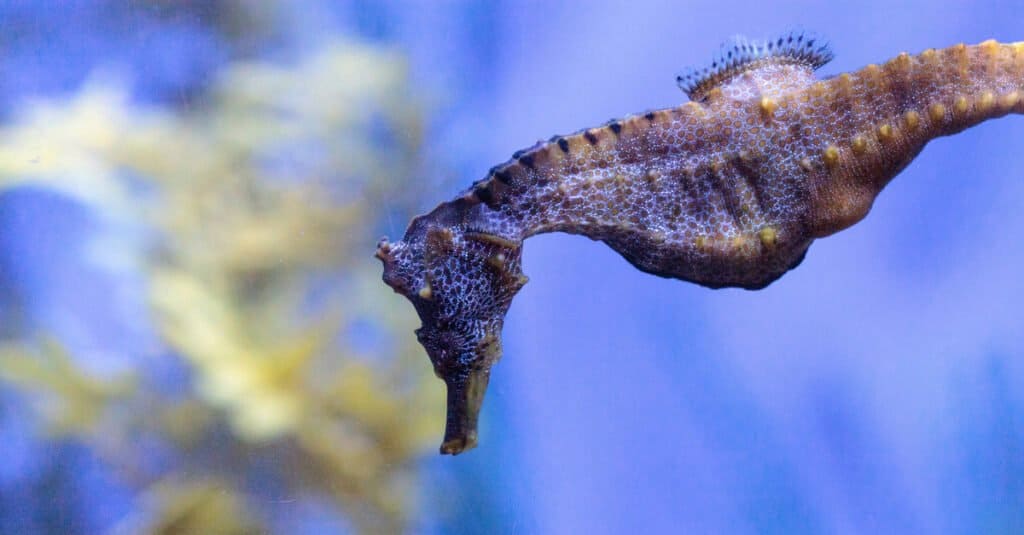
The Pacific Seahorse is the only known seahorse species to occupy waters of the western hemisphere natively. They come in many colors and sizes, though mostly dark gold, maroon, brown, or white. They may come in some combination of these colors or something else entirely though. Seahorses change colors depending on their surroundings!
©SunflowerMomma/Shutterstock.com
Coming in at about 12 inches in length, Pacific seahorses tend to come in gold, maroon, brown, white, or combinations of these colors. Females often have a dark line down their bodies, while males do not. This species is the only seahorse that lives in the West natively. They reside in waters to 200-foot depths along the coasts of Colombia, Costa Rica, El Salvador, Panama, Peru, Mexico, and the United States.
The photo featured at the top of this post is © Nichchima Anongjanya/ via Getty Images
Thank you for reading! Have some feedback for us? Contact the AZ Animals editorial team.







